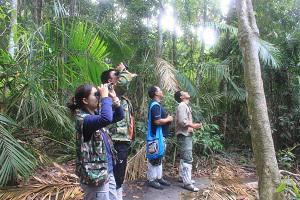Nantida Sutummawong
This study aims to provide a comprehensive assessment of the climate change vulnerability of rainforests birds, which accounts for ~25% of Thailand’s vertebrate biodiversity.

Bird survey at Khao Yai National Park.
Anthropogenic climate change is predicted to drive rapid changes in species' abundance and distributions, potentially resulting in significant levels of extinction among the world’s biota (Parmesan & Yohe 2003). Tropical mountains harbour a significant proportion of global avian biodiversity (Sekerkioglu et al, 2012), and Thailand is no exception, with 1,011 species recorded (Napheethapat et al. 2012). Although the magnitude of warming is predicted to be greater at high latitudes, tropical species may already be living closer to their maximum thermal tolerances and steep thermal gradients mean that even small changes could have disproportionally large impacts in montane systems (Deutsch et al. 2008). Despite this, there is a paucity of information regarding impacts of climate change on tropical montane birds (Sekerkioglu et al, 2012), and little is known about the potential extent of climate change impacts on the natural ecosystems in Thailand (The Thailand Research Fund 2011a). Coupled with this lack of information, there has already been an increase in average air temperature of 0.95°C between 1955 and 2009 in the region, exceeding the average increase of world temperature (The Thailand research fund 2011b). Thailand’s biodiversity is also threatened by the compounding effects of extensive deforestation, which may exacerbate impacts of climate change (Jetz et al 2007).

Chestnut-tailed Minla (Chrysominla strigula): Common bird at the summit of Doi Inthanon National Park.
The key output of my research is a series of high-resolution maps of where species are most vulnerable to climate change. These maps are essential for efficient national and regional conservation management in that they will allow for limited conservation resources to be employed most effectively on species and areas that are most in need of active management.
In addition, the data and interpretive tools that result from my project will be of direct benefit to the local managers of national parks and other stakeholders, including community groups and conservation NGOs. Specifically, the information and analyses that I will provide on the status, trends and threats to species is aimed to inform and catalyse local actions for biodiversity conservation.
My project will also build local capacity in biodiversity monitoring in ways that are suitable for detecting and predicting climate change impacts. Specifically, I will equip 12 - 16 local staff in Thailand with the techniques and knowledge needed for monitoring bird biodiversity across a network of 6 sites along the entire length of Thailand. The ultimate aim of building this local capacity is that the monitoring can continue well after my project ends, which will be crucial for detecting and adapting to long-term trends in Thailand's bird biodiversity.
Thus, the expected outputs from this project will have direct, practical relevance to regional and local biodiversity conservation in Thailand. There is a great need for this type of work in the country given that climate change and its interactions with human land-use represent one of the greatest challenges to its sustainable future.